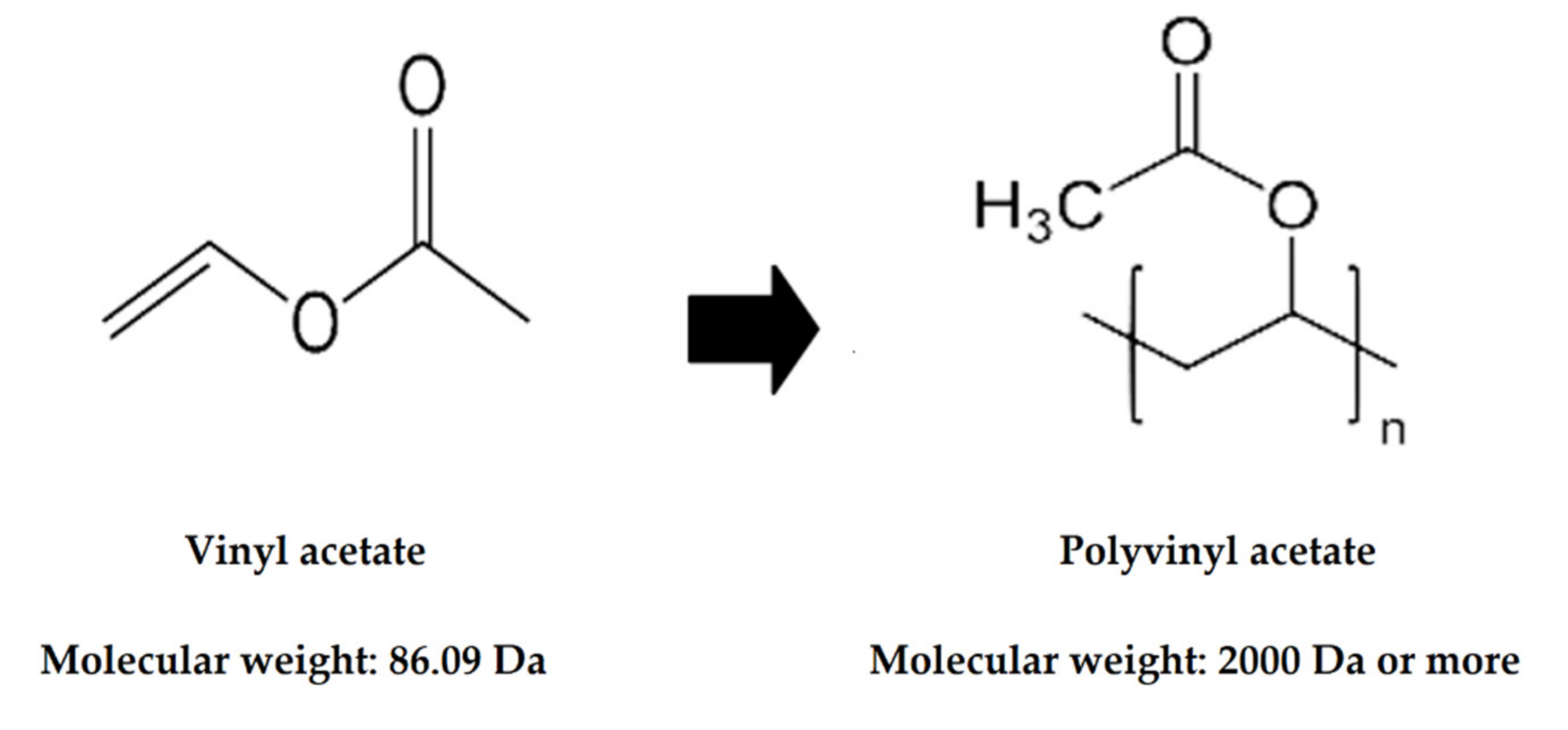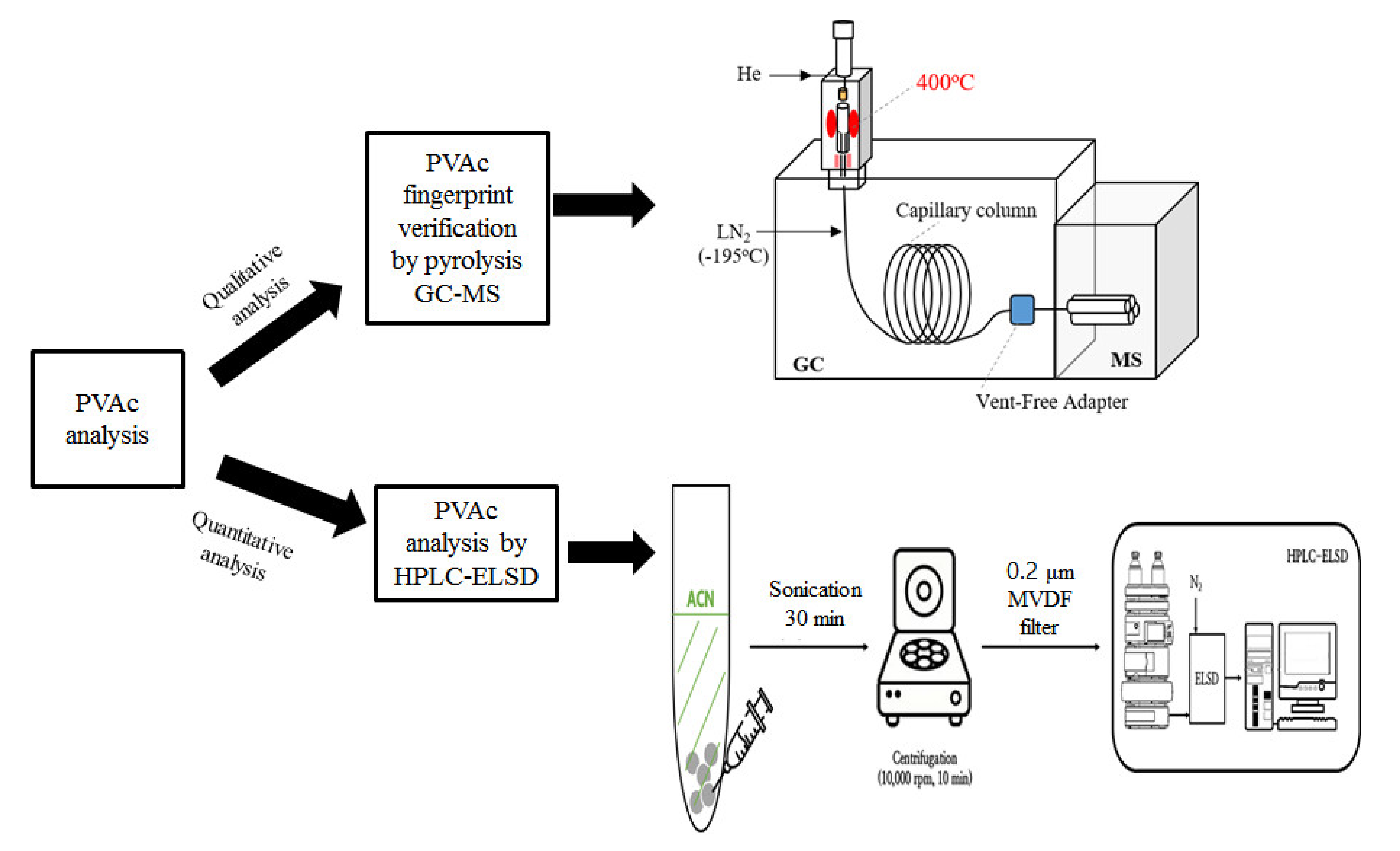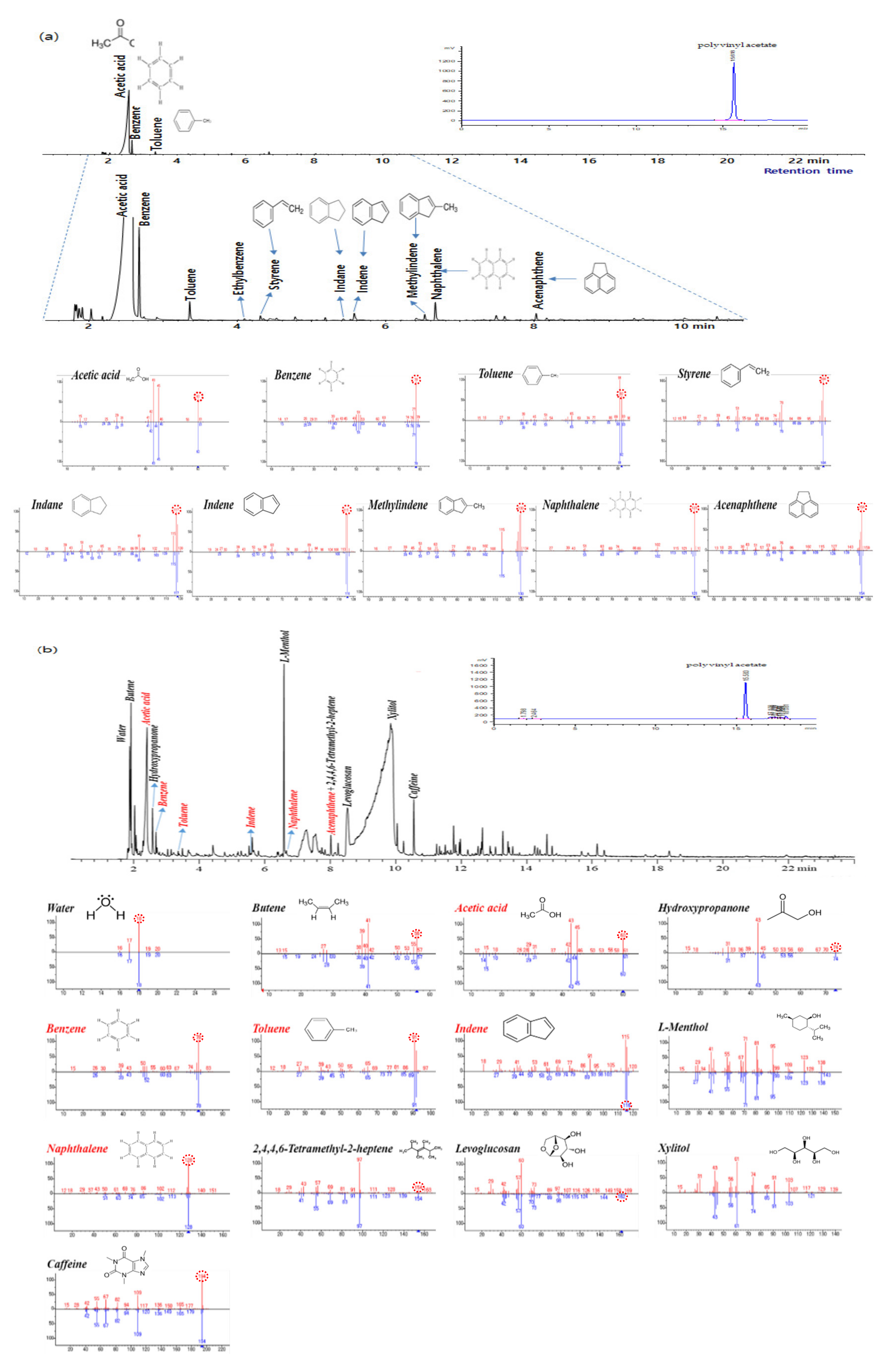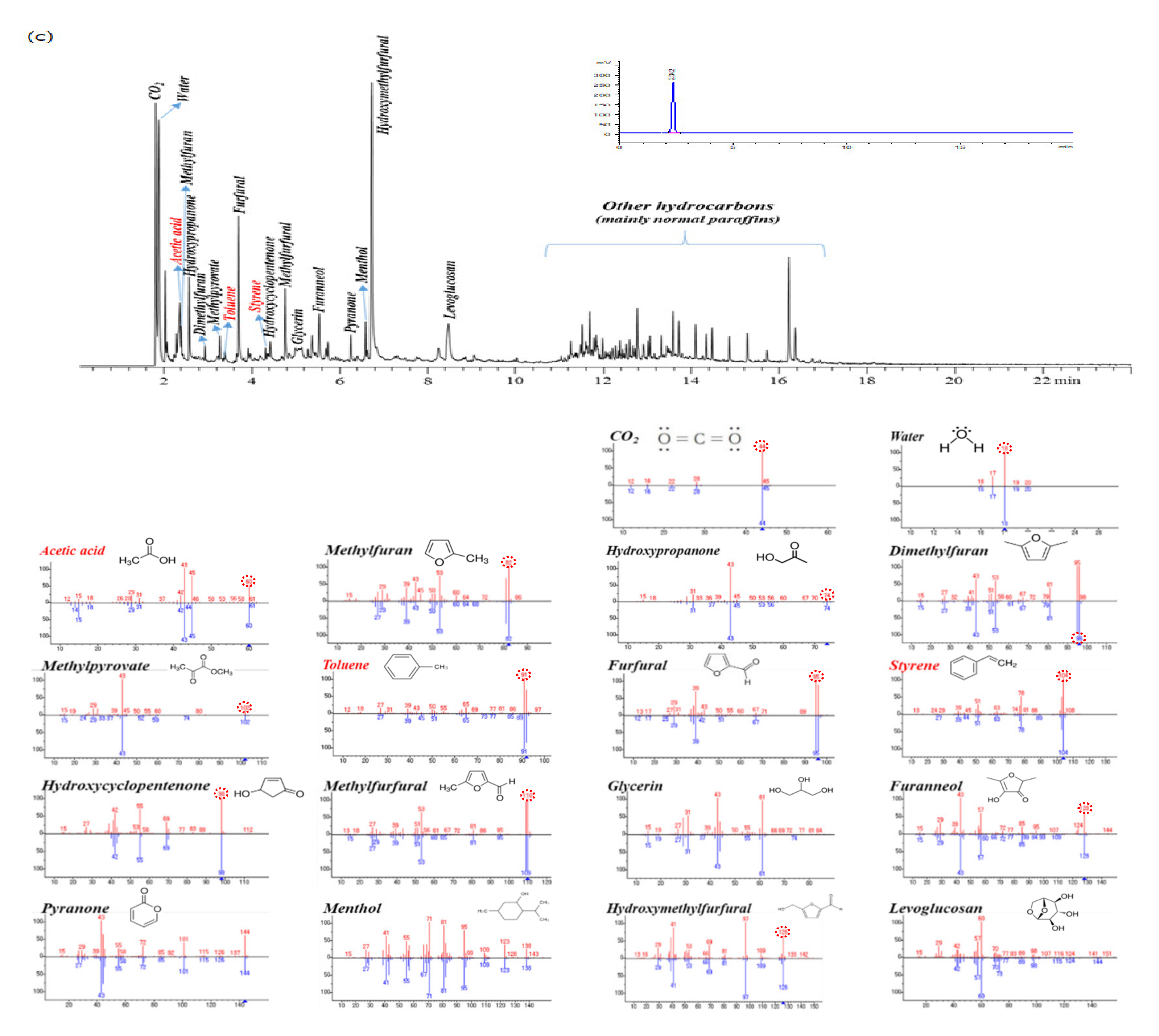Determination of Polyvinyl Acetate in Chewing Gum Using High-Performance Liquid Chromatography–Evaporative Light Scattering Detector and Pyrolyzer–Gas Chromatography–Mass Spectrometry
Abstract
:1. Introduction
2. Materials and Methods
2.1. Reagents and Reference Standard
2.2. Py–GC/MS Analysis
2.3. HPLC–ELSD Analysis
2.4. Method Validation for Quantitative Analysis
3. Results and Discussion
3.1. Py–GC–MS Analysis
3.2. HPLC–ELSD Analysis
3.3. Method Validation of Quantitative Analysis
3.3.1. Linearity, LOD, and LOQ
3.3.2. Matrix Effect
3.3.3. Accuracy and Precision
3.3.4. Cross-Laboratory Test
3.4. Applying the Method to Gum Samples
4. Conclusions
Supplementary Materials
Author Contributions
Funding
Conflicts of Interest
References
- KoSFoST (Korean Society of Food Science and Technology). Polyvinyl Acetate, Food Science and Technology Dictionary. Available online: https://terms.naver.com/entry.nhn?docId=296974&cid=602-62&categoryId=60262 (accessed on 4 August 2019).
- Assembly of Life Sciences (U.S.); Food and Nutrition Board; Committee on Codex Specifications. Food Chemicals Codex Issue 1 of Food Chemicals Codex: First Supplement to the Third Edition, National Research Council (U.S.): Committee on Food Chemicals Codex, 3rd ed.; National Academy Press: Washington, DC, USA, 1981; p. 237. [Google Scholar]
- MFDS (Ministry of Food and Drug Safety). Korea Food Additives Code; Ministry of Food and Drug Safety: Osong, Korea, 2018. [Google Scholar]
- JFCRF (The Japan Food Chemical Research Foundation). Standards for Use According to Use Categories Japan. Available online: https://www.ffcr.or.jp/en/upload/Standards%20for%20Use%20Jan.15.2020.pdf (accessed on 6 June 2019).
- FDA (U.S. Food and Drug Administration). Substances Added to Food (Formerly EAFUS). Available online: https://www.accessdata.fda.gov/scripts/fdcc/index.cfm?set=FoodSubstances&id=POLYVINYLACETATE (accessed on 1 April 2019).
- Spectrum Chemical MFG Corp. Polyvinyl Acetate MSDS. Available online: https://www.spectrum-chemical.com/MSDS/ZQ446.pdf (accessed on 4 August 2019).
- IARC (International Agency for Research on Cancer). Vinyl acetate, polyvinyl acetate and polyvinyl alcohol. iarc monographs on the identification of the carcinogenic hazards to humans. IARC Monogr. Eval. Carcinog. Risk Chem. Hum. 1971, 19, 341. [Google Scholar]
- Sellier, N.; Jones, C.E.; Guiochon, G. The examination of some vinyl acetate/olefin copolymers by pyrolysis gas chromatography mass spectrometry. J. Chromatogr. Sci. 1975, 13, 383–385. [Google Scholar] [CrossRef] [PubMed]
- Tsuge, S.; Ohtani, H.; Watanabe, C. Poly (vinyl acetate). In PVAC: Pyrolysis-GC/MS Data Synthetic Polymers; Elsevier: Amsterdam, The Netherlands, 2011; pp. 146–147. [Google Scholar]
- Uyar, T.; Tonelli, A.E.; Hacaloglu, J. Thermal degradation of polycarbonate, poly (vinyl acetate) and their blends. Polym. Degrad. Stab. 2006, 91, 2960–2967. [Google Scholar] [CrossRef]
- Renuka Devi, K.B.; Madivanane, R. Normal coordinate analysis of Polyvinyl acetate. Eng. Sci. Technol. Int. J. 2012, 2, 2250–3498. [Google Scholar]
- Bianco, G.; Zianni, R.; Anzillotta, G.; Palma, A.; Vitacco, V.; Scrano, L.; Cataldi, T.R. Dibenzo-p-dioxins and dibenzofurans in human breast milk collected in the area of Taranto (Southern Italy): First case study. Anal. Bioanal. Chem. 2013, 405, 2405–2410. [Google Scholar] [CrossRef] [PubMed]
- NIFDS (National Institutte of Food and Drug Safety Evaluation). Guidelines for the Validation of Drugs; National Institute of Food and Drug Safety Evaluation: Osong, Korea, 2015; pp. 10–12. [Google Scholar]
- KFDA (Korea Food and Drug Administration). Korean Food Additives Code, Standards and Specifications for Food Additives; Korea Food and Drug Administration: Osong, Korea, 2013. [Google Scholar]
- EMEA (European Medicines Agency). Validation of Analytical Procedures: Text and Methodology; European Medicines Agency: London, UK, 2006. [Google Scholar]
- Ur-Rehman, S.; Mushtaq, Z.; Zahoor, T.; Jamil, A.; Murtaza, M.A. Xylitol: A review on bioproduction, application, health benefits, and related safety issues. Crit. Rev. Food Sci. Nutr. 2015, 55, 1514–1528. [Google Scholar] [CrossRef] [PubMed]
- Andrew, F.; Ajmol, A.; Nicholas, G. Caffeine enhances cognitive function and skill performance during simulated soccer activity. Int. J. Sport Nutr. Exerc. Metab. 2009, 19, 410–423. [Google Scholar]
- Caprita, A.; Caprita, R.; Simulescu Gianet, V.O.; Drehe, R.-M. Dietary fiber: Chemical and functional properties. J. Agroaliment. Process. Technol. 2010, 16, 406–416. [Google Scholar]
- The 80th JECFA Monographs 17. 2015. Available online: http://www.fao.org/fileadmin/user_upload/jec-fa_additives/docs/monograph17/additive-542-m17.pdf (accessed on 13 March 2019).
- Lee, P.J.; Yang, J.; Di Gioia, A.J. Waters Polymer Analysis Applications Note; Water Corporation: Sydney, Australia, 2013; pp. 33–37. [Google Scholar]
- Chong, H.S.; Sim, S.; Yamaguchi, T.; Park, J.H.; Lee, C.; Kim, M.K.; Lee, G.Y.; Yun, S.S.; Lim, H.S.; Suh, H.J. Simultaneous determination of sodium iron chlorophyllin and sodium copper chlorophyllin in food using high-performance liquid chromatography and ultra-performance liquid chromatography–mass spectrometry. Food Chem. 2019, 276, 390–396. [Google Scholar] [CrossRef] [PubMed]
- EC (European Commission). Method Validation and Quality Control Procedures for Pesticide Residue Analysis in Food and Feed; Document No. SANCO/3131/2007; European Commission: Brussels, Belgium, 2007; Available online: http://www.crlpesticides.eu/lib-rary/docs/allcrl/AqcGuidance_Sanco_2007_3131.pdf (accessed on 25 April 2019).
- FAO (Food and Agriculture Organization). Validation of Analytical Methods for Food Control; A Report of a Joint FAO/IAEA Expert Consultation; FAO: Rome, Italy, 1998; pp. 687–689. [Google Scholar]




| Conc. (μg/mL) | Inter-day test (n = 3) | ||
| Measured concentration (μg/mL) | Accuracy (Recovery%) | Precision (RSD%) | |
| 200 | 186.3 ± 8.0 | 86.6 ± 5.6 | 6.4 |
| 300 | 310.3 ± 22.3 | 103.4 ± 7.4 | 7.2 |
| 400 | 408.1 ± 6.0 | 115.3 ± 3.9 | 3.4 |
| 500 | 521.0 ± 39.0 | 104.2 ± 7.8 | 7.5 |
| 600 | 622.8 ± 15.6 | 107.5 ± 3.7 | 3.5 |
| 700 | 776.6 ± 32.4 | 110.9 ± 4.6 | 4.2 |
| 800 | 799.8 ± 10.0 | 98.6 ± 0.6 | 0.6 |
| 900 | 900.2 ± 22.6 | 100.0 ± 2.5 | 2.5 |
| 1000 | 983.9 ± 4.8 | 93.8 ± 4.0 | 4.2 |
| Conc. (μg/mL) | Intra-day test (n = 5) | ||
| Measured concentration (μg/mL) | Accuracy (Recovery%) | Precision (RSD%) | |
| 200 | 201.9 ± 6.3 | 101.0 ± 3.1 | 3.1 |
| 300 | 306.4 ± 25.1 | 100.8 ± 3.5 | 3.4 |
| 400 | 454.2 ± 16.5 | 113.6 ± 4.1 | 3.6 |
| 500 | 587.6 ± 33.4 | 105.2 ± 9.5 | 9.0 |
| 600 | 643.1 ± 17.1 | 107.2 ± 2.8 | 2.7 |
| 700 | 746.8 ± 23.8 | 115.0 ± 0.5 | 0.4 |
| 800 | 798.2 ± 507 | 99.8 ± 0.9 | 0.9 |
| 900 | 885.4 ± 25.8 | 101.0 ± 1.8 | 1.8 |
| 1000 | 980.7 ± 19.8 | 98.1 ± 2.0 | 2.0 |
| Lab 1 | Lab 2 | Lab 3 | Precision (RSD%) | |||||
|---|---|---|---|---|---|---|---|---|
| Measured Concentration (μg/mL) | Accuracy (Recovery%) | Measured Concentration (μg/mL) | Accuracy (Recovery%) | Measured Concentration (μg/mL) | Accuracy (Recovery%) | |||
| Concentration (μg/mL) | 300 | 279.0 ± 11.3 | 93.0 ± 4.1 | 287.0 ± 3.5 | 93.7 ± 3.6 | 269.9 ± 2.1 | 90.0 ± 0.7 | 1.7 |
| 500 | 508.0 ± 8.0 | 101.6 ± 1.6 | 483.3 ± 3.1 | 96.7 ± 0.6 | 503.7 ± 5.0 | 100.7 ± 1.0 | 2.1 | |
| 700 | 761.0 ± 16.5 | 108.7 ± 2.2 | 897.3 ± 5.6 | 114.2 ± 0.5 | 703.0 ± 9.3 | 100.4 ± 1.3 | 5.3 | |
| Linearity (R2) | 0.9926 | 0.9965 | 0.9990 | |||||
| Sample Information (Purchased Location) | Origin | PVAc in Gum (g/kg) |
|---|---|---|
| Gum 1 (Korea) | Cheongju, Korea | 8.4 ± 0.1 |
| Gum 2 (Korea) | Cheongju, Korea | 10.8 ± 0.1 |
| Gum 3 (Korea) | Cheongju, Korea | 9.8 ± 0.0 |
| Gum 4 (Korea) | Cheongju, Korea | 9.0 ± 0.0 |
| Gum 5 (Korea) | Cheongju, Korea | n.d. a |
| Gum 6 (Korea) | Cheongju, Korea | 9.1 ± 0.1 |
| Gum 7 (Internet) | Madrid, Spain | 5.1 ± 0.2 |
| Gum 8 (Internet) | Madrid, Spain | 4.9 ± 0.1 |
| Gum 9 (Internet) | Madrid, Spain | 5.7 ± 0.0 |
| Gum 10 (Internet) | Chicago, USA | 13.8 ± 0.1 |
| Gum 11 (Internet) | Chicago, USA | 4.3 ± 0.1 |
| Gum 12 (Internet) | Chicago, USA | 13.2 ± 0.3 |
| Gum 13 (Internet) | Hanover, USA | 6.3 ± 0.1 |
| Gum 14 (Korea) | Japan | 6.5 ± 0.0 |
| Gum 15 (Korea) | Japan | 6.9 ± 0.1 |
| Gum 16 (Korea) | Japan | 5.2 ± 0.0 |
| Gum 17 (Korea) | Japan | 6.9 ± 0.1 |
| Gum 18 (Internet) | Langley, Canada | 12.2 ± 0.1 |
| Gum 19 (Internet) | Germany | n.d. |
| Gum 20 (Internet) | Germany | n.d. |
Publisher’s Note: MDPI stays neutral with regard to jurisdictional claims in published maps and institutional affiliations. |
© 2020 by the authors. Licensee MDPI, Basel, Switzerland. This article is an open access article distributed under the terms and conditions of the Creative Commons Attribution (CC BY) license (http://creativecommons.org/licenses/by/4.0/).
Share and Cite
Sim, S.; Kim, Y.-M.; Park, Y.-J.; Siddiqui, M.X.; Gang, Y.; Lee, J.; Lee, C.; Suh, H.-J. Determination of Polyvinyl Acetate in Chewing Gum Using High-Performance Liquid Chromatography–Evaporative Light Scattering Detector and Pyrolyzer–Gas Chromatography–Mass Spectrometry. Foods 2020, 9, 1473. https://doi.org/10.3390/foods9101473
Sim S, Kim Y-M, Park Y-J, Siddiqui MX, Gang Y, Lee J, Lee C, Suh H-J. Determination of Polyvinyl Acetate in Chewing Gum Using High-Performance Liquid Chromatography–Evaporative Light Scattering Detector and Pyrolyzer–Gas Chromatography–Mass Spectrometry. Foods. 2020; 9(10):1473. https://doi.org/10.3390/foods9101473
Chicago/Turabian StyleSim, Sol, Young-Min Kim, Yeong-Ju Park, Mohammed Xain Siddiqui, Yejin Gang, Jihyun Lee, Chan Lee, and Hee-Jae Suh. 2020. "Determination of Polyvinyl Acetate in Chewing Gum Using High-Performance Liquid Chromatography–Evaporative Light Scattering Detector and Pyrolyzer–Gas Chromatography–Mass Spectrometry" Foods 9, no. 10: 1473. https://doi.org/10.3390/foods9101473
APA StyleSim, S., Kim, Y.-M., Park, Y.-J., Siddiqui, M. X., Gang, Y., Lee, J., Lee, C., & Suh, H.-J. (2020). Determination of Polyvinyl Acetate in Chewing Gum Using High-Performance Liquid Chromatography–Evaporative Light Scattering Detector and Pyrolyzer–Gas Chromatography–Mass Spectrometry. Foods, 9(10), 1473. https://doi.org/10.3390/foods9101473









